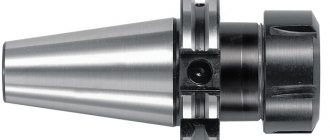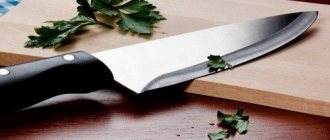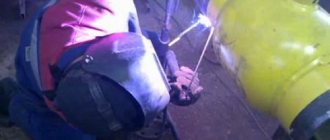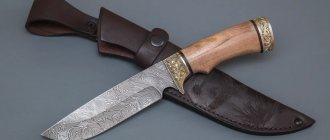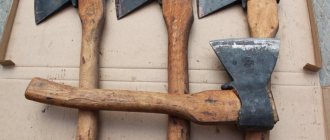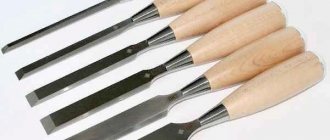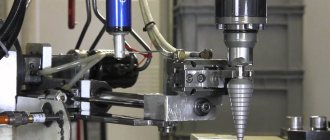Modern craftsmen who process lumber must have an electric plane in their arsenal. It has significant advantages over hand tools. To ensure maximum equipment performance, proper installation of the knives on the electric planer is necessary. The precise position of sharp knives increases the productivity of the machine.
Types of knives for electric planer
The tool has a rotating drum on which the cutting parts are fixed. The drum is secured with ordinary nuts. If you loosen them, it will be possible to remove the knives. Since the blade has two sharpening sides, if one of the sides becomes dull, the knife can be quickly turned over.
The industry produces several blades for such a tool . They differ in their design and shape:
- Direct. Planing of small workpieces. You can choose a quarter.
- Wavy. They imitate “aged” wood.
- Rounded. They are used for processing wide surfaces when it is necessary to make a neat shaped transition between planing planes.
Knives differ not only in their shape. Their size also plays a major role. There are several groups:
- Plates - 82x5.5x1.2 mm. They are used on foreign equipment such as Black&Deccer. Carbon steel is used to make the blade.
- Special knives. They differ from plates in their dimensions. They are much thicker and wider. Available in lengths of 82 or 102 mm. The large thickness makes it easier to sharpen the tool.
- Blades for a specific device. Typically the blade width does not exceed 110 mm. To secure the blade, special holes are provided.
Disposable knives
Knives intended for disposable use are made of steel-based hard alloys in the form of plates sharp on both sides. Such cutting parts cannot be sharpened. After the edge being used is completely worn out, the blade is turned over and placed on the drum with the other side. At the same time, the tool continues to work. If the second cutting edge becomes dull, then the blade is simply thrown away.
Disposable knives are intended only for performing work that does not require high precision and quality of workpiece processing. But they are convenient for practical use: during installation they do not need to be precisely adjusted and balanced.
The shapes of disposable products are:
- straight;
- wavy;
- straight, but rounded at the ends.
The first type of product has a straight cutting part. It is convenient to use such consumables to process parts that have a smaller width than the length of the installed blade, and to select quarters. Wavy knives are used when it is necessary to carry out rough processing of lumber. With their help, you can give a wooden surface a different texture, for example, to simulate “aging.” Straight cutting edges, rounded at the edges, are good because they do not leave marks (grooves, steps) on the surface of the wood being processed. This is a suitable option if you need to work with wide wooden pieces.
Disposable blades have a longer service life, but can break quite easily if they accidentally collide with metal (for example, a nail, bolt). They are the best option for attachments when it is necessary to work with hard wood workpieces.
Reusable cutting attachments
Products that are intended for reusable use differ in both their shape and size from disposable cutting attachments. They are made using high quality steel, which ensures ease and quality of processing of wooden surfaces.
Using reusable knives, you can achieve such a smooth surface of the workpiece that grinding is not required. They are marked HSS (fully High-Speed Steel, which translates as high-speed steel). These blades are considered professional. Their installation is accompanied by high-precision balancing and adjustment. The sharpening must also be of excellent quality. In this case, tool high-speed steel can be sharpened so that it is very sharp.
It is more profitable to buy reusable cutting attachments because they can be sharpened multiple times. But high-speed steel products do not allow processing hardwood (for example, larch or oak).
The working drums of most models of electric planes can be equipped with both disposable and reusable cutting attachments. But there are also devices that can only be equipped with blades that are not intended for sharpening. For this reason, when purchasing an electric planer, it is recommended to give preference to universal power tools.
Classification by size
Knives for electric planers can be standard or non-standard sizes. Products of the first type, called “plates,” have a length of 82 mm, a width of 5.5 mm, and a thickness of 1.2 mm. Such cutting attachments are suitable for most models of electric planes from foreign companies Makita, Skil, Bosch, Black&Dekker.
Straight knives for electric planers Bosch, SKIL
Non-standard cutting attachments with larger blade widths and thicknesses are typical for electric planers from Baikal and Interskol. Due to their parameters, they are stronger and better than standard plates. When they come into contact with metal, such knives do not break. They can be sharpened using sandpaper. The width of the nozzles is about 1 cm. The length can be 82 mm, 102 mm, and for products from the Rebir company it reaches 110 mm.
Straight knives for electric planer Rebir IE-5709
The price of the cutting attachment depends on the manufacturer. Also, this factor often determines the quality of the product. If you purchase knives from well-known companies (for example, Bosch), you can count on their long service life.
Some models of electric planers are equipped with cutting attachments of unusual shape and design. In order not to be mistaken with the dimensions, it is recommended to take the old blade with you for comparison before purchasing.
Knife design
Before you start learning how to sharpen knives on an electric planer, you need to understand their designs. It consists of two main parts - supporting and working, which contain several elements:
- working angle;
- front corner;
- chamfer on the back of the blade;
- back angle of the chamfer.
When sharpening the cutting element of a power tool, the greatest attention should be paid to the front angle. The smoothness of the surface after planing, the load on the blade, and the efficiency of removing sawdust from the working area will depend on how correctly it was sharpened.
Included with electric planer
When you install a separate side stop on the electric planer (it is usually supplied as a kit), you can perform folding . The stop, fixing the tool at a certain distance, must touch the workpiece.
Folding boards
» data-medium-file=»https://odnastroyka.ru/wp-content/uploads/2014/11/falcevanie.jpg» data-large-file=»https://odnastroyka.ru/wp-content/uploads /2014/11/falcevanie.jpg» /> Folding the board
folding depth depends on the number of passes the plane makes over the workpiece. The more passes, the deeper the rebate.
After planing, remove the knives from the electric planer, wash them with kerosene and place them in a separate box until next time.
When do you need to adjust or replace electric planer knives?
The knives on an electric planer wear out over time. They need to be removed and sharpened or replaced altogether, and then installed back on the drum. Newly installed cutting attachments need to be adjusted in order to process lumber as efficiently as possible. The blades of new power tools also need to be pre-adjusted before use.
The following signs indicate that adjustment is necessary:
- change in sound when processing workpieces;
- vibration of the tool during operation;
- deterioration in the quality of planing lumber (formation of waves, chips, grooves, protruding fibers and other defects);
- increase in effort spent on work.
The change in sound is not typical for all models. This symptom may also indicate a number of other problems.
If, after adjusting the blade blades, the symptoms discussed above do not disappear, then more serious repairs to the power tool will be required.
Setting the correct position of the cutting attachments is carried out according to the following parameters:
- the height of the part of the blade that protrudes above the sole of the power tool;
- the size of the side protrusion of the knife intended for picking out quarters.
By correctly adjusting the position of the knife blades on the drum, high final quality of lumber processing is achieved.
Briefly about the main thing
To work effectively with an electric planer, you need to remember a number of rules:
- Before purchasing a plane, turn the tool on at idle speed several times. This way you can check the smoothness of operation, the presence of vibration, and determine some of the advantages and disadvantages of the device.
- Process boards in the direction of the grain.
- If the plane gets stuck or produces shaggy shavings, it is necessary to sharpen the blades on the knives. It is advisable to entrust this to specialists.
- Do not put pressure on the electric planer when working.
- The straighter the heel is relative to the drum, the better the cut will be.
- When working with the side stop, you need to take into account that it moves along the edge of the board, and, naturally, if the end is curved, then the notch will be “ribbed”.
- To ensure that the cutting depth is approximately the same throughout the entire board, at the beginning of the pass, apply more force to the front of the plane, and at the end - to the back.
- If you are working with a long beam, during processing you need to calmly move along it parallel to the tool. This way you can avoid steps.
An electric plane is a complex tool. Both during selection and during operation. One way or another, due to certain advantages, this is almost the only device for home carpentry work. If you decide to save money on planing boards, purchasing a plane will be the right decision.
Adjusting, sharpening and installing knives for electric planers
Modern craftsmen who process lumber must have an electric plane in their arsenal. It has significant advantages over hand tools. To ensure maximum equipment performance, proper installation of the knives on the electric planer is necessary. The precise position of sharp knives increases the productivity of the machine.
Adjusting tool knives
A woodworking master knows very well how to adjust the knives on an electric planer . To perform this work you must have:
- Hexagon included with the product.
- Metal ruler.
In order to set up a tool with several knives quickly and correctly, it is necessary to follow a certain technological sequence:
Turning the device over, you need to remove tar deposits from the canvas with a solvent.
- The front side of the sole is exposed. Its position must correspond to the minimum planing depth.
- Each blade is installed in the gap between the plates.
- The ruler is placed on the base plate. Moreover, the cutting edge must touch the supporting surface. If this does not happen, you need to loosen the fastening bolts and set the desired level.
- Then tighten the bolts.
- All attachments are subjected to the operation. The exposed gaps must have the same dimensions. As a result, vibration and tool imbalance are eliminated.
- To determine the ease of rotation of the drum on the shaft, you need to turn it by hand.
- To check the correctness of the settings, process the unnecessary workpiece.
If the knife has a straight shape, the protrusion of the working part should reach 0.5 mm. For a rounded shape, this size should be more than 1 mm.
How to properly set up and use a plane?
- Device and purpose
- Stages of preparing the tool for work
- How to use?
- Safety regulations
Proper adjustment of the plane guarantees high-quality and safe work. To achieve a good result, it is important to follow all stages of preparation for work, adjust the installation angle of the hand plane knife and other parameters. This is what we will talk about today.
Hand electric plane
The first electric planer was released by Makita. Today it is difficult for a master to imagine life without this incredibly useful tool.
How to adjust an electric planer
Adjustment of electric plane knives should be carried out according to the situation using a special adjustment mechanism, which is located on the front handle of the electric plane. By rotating this handle, we achieve the required amount of release of the knives (0-2 mm); they should be positioned evenly, parallel to the bed. Excessive release makes work difficult and puts additional stress on the plane motor.
Safety requirements
If you use the tool correctly, you can quickly and efficiently complete a fairly large amount of work. However, if you do not adhere to safety requirements, you can suffer significant injuries.
- Before work, the workpiece must be securely fixed, otherwise it may move or even fly off during work.
- During the technical inspection of the blades and their adjustment, the electric planer must be de-energized by unplugging the cord and plug from the socket, because accidental starting can lead to very unfavorable consequences.
- You need to start processing only after the knives have started and warmed up, that is, the cutting elements must accelerate to the required speed.
- The instrument must be placed exclusively on its side.
When working, avoid bending or tangling the cord that supplies power. Electrical insulation and integrity are also required.
Maintaining safety when working with a plane
If the tool is used correctly, you can get a fair amount of work done in a short period of time, but serious injury can result if you do not take proper precautions.
Before starting work, it is important to secure the workpiece properly, otherwise there is a risk that it could be pulled out during work and could cause injury to workers or others nearby.
When performing a technical inspection of cutting elements or when adjusting knives, the tool should be completely de-energized by disconnecting the electrical cord from the mains, since accidental starting can cause irreparable harm to health.
Products should begin to be processed by turning on the device in advance and allowing the knives to gain the required speed until the cutting elements come into contact with the wood.
If it is necessary to put the plane to the side to check the surface being processed, it is important to place it on its side.
During operation, avoid kinking the electrical cord. The integrity of the electrical insulation must be maintained. It must be undamaged, and current-carrying elements must be carefully insulated.
Using a device with dull blades increases the load on the motor, which can lead to premature wear. In addition, the quality of processing deteriorates.
Sharpening power tool knives at home is not that difficult if you are careful.
Necessary materials
- sharpening stone: coarse-grained - for primary sharpening, fine-grained - for final sharpening;
- two laminate boards, a wooden block - if you need to make a sharpener yourself.
Tools
- hacksaw;
- grinder;
- knife clip;
- ruler;
- screwdriver;
- pencil;
- wood knife;
- chisel;
- hammer;
- mounting screws and studs;
- electric drill;
- plane knife;
- two identical bearings.
How to properly sharpen with your own hands:
2. Carefully screw them to the clamp so that the edges lie in the same plane.
3. Gently, with light pressure, move the knives along the abrasive. It is important to ensure that the blades are sharpened at the same time. This way the original sharpening angle will be maintained.
Advice : to prevent dust from the abrasive being ground from flying into your face, it is better to wet the stone in advance.
4. Check the work: inspect the knives for defects, make sure that the cutting part is sharp enough.
How to properly align knives on an electric planer?
- 25-01-2015
- 17
- 994
In the age of modernization, the market is rich in various construction tools that simplify and speed up the work process. Also, not a single repair or construction can be done without an electric planer.
Each tool has additional components, but for a plane these additional elements are knives, with which the wood is processed. These knives are double-sided and come in a set of two pieces.
If the cutting elements become difficult to remove chips, it means that they have become inoperative and need to be sharpened.
Electric planer device.
But, before you start disassembling the tool, you need to know how to position the knives on the electric planer. In this regard, it is important to study in detail the principles of disassembling a plane.
Installing knives: recommendations
The cutting elements are mounted on the plane drum, which rotates. The purpose of the knives is to plan the top layers of wood during the processing of products. This design is equipped with one or two cutting elements.
The knives standing last are rotary; if necessary, their position can be easily changed if one of the sides is dull. Electric planer knives are made from tungsten carbide or tool steel.
Products made of steel can be re-sharpened.
The blades have different configurations and are divided by shape:
- Straight - they are installed when selecting quarters and when processing small parts.
- Rounded - used when planing wide areas of parts, since the transitions between planed lines are made smoothly.
- Wave-shaped - similar knives are used when simulating antiquity on wood.
Diagram of options for sharpening a plane knife: a – on a whetstone, b – on a whetstone, c – position of the cutter blade chamfer when sharpening on a whetstone, d – sharpening on a whetstone disk using a stop device.
Self-adjustment of electric planer knives
Timely and correctly adjusted adjustment of the electric planer knives allows you to fully use the full potential of this magnificent tool.
With the correct adjustment of the electric planer blades, you can handle large volumes of material without much effort.
New models of electric planers allow you to cope with large volumes of material without much effort. An electric planer can be used to do both rough and finishing wood processing. Some models of electric planers allow you to obtain such good results that there is no need to grind the surface.
The cleanliness of the treated surface directly depends on the depth at which planing is carried out. The planing depth for some models is set in increments of 0.1 mm. When purchasing a tool, you need to pay special attention to this parameter. In general, setting up knives for work should always be done very carefully.
Characteristics of knives for power tools
The electric planer device includes two knives, which have two cutting surfaces and are simply removed.
An electric planer allows you to process the surface with high quality, while maintaining certain dimensions. But the outcome of the work directly depends on the selection of knives. Often during use an unpleasant defect occurs - the surface looks wavy. The reason is the slight difference in height. The problem can be solved by correct adjustment and replacement of electric planer knives with spiral ones.
Power tools usually come with two blades. They are most often made from high-strength hardened steel. Less common are tungsten blades. They are sharpened using a special mechanism in which the knife is secured and the sharpening angle is set.
When purchasing knives, you need to consider their safety. Most often, power tools are equipped with two types of protection:
- protection of the surface being processed;
- finger protection.
Many electric planers have a protective plate, which, when working, covers the drum, allowing you to process the surface at different depths and at any distance.
The regulation mechanism is located on the handle of the electric planer. Activating the mechanism causes the knives to extend. Adjustment depth 2 mm.
Electric planer knives are sharpened according to the same principle as for hand tools. The only difference is the number of blades. The electric planer has two of them and they are replaced only in pairs. Using blades from the same set avoids imbalance. Violation of this rule will lead to very low processing quality and accelerated tool failure.
Sequence of technological steps when replacing and adjusting knives
The power tool must first be de-energized. Failure to observe this precaution may result in serious injury. If the plane has already been used for quite a long time, it is necessary to remove the accumulated resin using a cotton wool soaked in white alcohol.
Options for sharpening a plane knife.
Then you need to put a ruler on the edge of the sole to see whether the ends of the knives touch it. If there is no contact, then adjustment of the position of the knives is required.
In the next step, you will need the key that comes with the power tool. With its help, you need to slightly loosen the blades installed in the holder. The cutting part of the blades should protrude slightly and be parallel to the sole. Typically, the output of the cutting part of a flat knife does not exceed 0.5 mm. In this case, the shrechbel (or sherhebel), a rounded knife used for rough planing, can be adjusted by 1 mm or more.
When working, it is important to constantly turn the adjusting screw until the blade is in place. The screws that enable the rotation are located at the back of the planer blade platform.
Then the knives are secured using special fasteners to the top plate.
The knives are moved so that they are installed in line with the ruler, without allowing any gaps. As a last resort, you need to leave a small “spade”. These measures will help prevent elements from becoming unbalanced.
After completing the adjustment, the bolts should be tightened. At the same time, you need to check that they are tightened well. Then you need to check that the knives do not touch the body of the electric planer. To do this, you need to lightly turn the drum.
New electric planers, as a rule, have adjusted fasteners, but during operation the blades often get knocked down. If the tool has not been used for a long time, you need to check the condition of the knives before starting work.
Immediately after setting up, you should not start working on parts that are intended to be used in the future. It is better to check the operation of the electric planer on an unnecessary workpiece and, if necessary, re-adjust.
Features of the work
Before you start sharpening, you need to select the sharpening angle of the plane knife. This indicator is influenced by various factors:
- Properties of the tree that will be processed. To work with soft wood (larch, linden, pine, aspen), the optimal angle range is from 40 to 50 degrees. For hard wood (oak, hornbeam, maple, pear), set the angle to 55–65 degrees.
- Setting the tool at a certain angle. The quality of planing also depends on this indicator. For soft wood - about 40 degrees, for hard wood - about 25.
- The material from which the cutting edge is made.
After thoroughly studying the tool and selecting the materials to be processed, you can begin resharpening the plane at home.
Hand planes
Step-by-step instructions for sharpening a hand plane:
- Determine the sharpening angle.
- Unscrew the clamping bolts and remove the blade.
- Place a coarse-grit whetstone in a vice.
- Use the chamfer of the blade to make circular movements on the abrasive material.
Movements should be slow. When sharpening, the metal is moistened with water. After processing with large grains, a fine-grained stone is used. Sharpening of a plane, which is intended for manual planing, can be carried out on a special machine.
Electric planers
The main difference between electric planer blades and hand tools is double-sided sharpening. When one side becomes dull, the knife is turned over to continue planing. Their sharpening is carried out using sharpening machines. Step-by-step instructions for sharpening planer knives:
- Unscrew the blade from the tool.
- Moisten the abrasive stone with water and set the speed to low.
- Start the engine.
Minor damage and unevenness can be restored using sandpaper. We must not forget that blades for electric tools can be made of hard alloys. If such a cutting edge is dull on both sides, the element will have to be replaced.
Knives for electric planers become dull faster than those for hand tools. This is due to high planing speeds. To sharpen them, it is necessary to use specialized equipment, accurately set the angles and the number of revolutions of the abrasive wheel. Exceeding the speed will lead to loss of hardness and destruction of the cutting edge.
Planing with an electric planer
A separate condition for correct and safe planing of any structures with electric planers is the rigid fixation of the workpiece being processed.
Only after the workpiece being processed is clearly fixed, you can start planing it. First you should start with rough processing. For this, sherhebel is often used. When using scherhebel, movements should be directed not along, but across the fibers. Otherwise, you may cut off too much wood.
Subtleties of working with an electric planer
After finishing processing the surface of small workpieces with Sherhebel, it should be cleaned first with a single, then with a double plane. If you are dealing with long workpieces, such as bars, then it is better to use a jointer or semi-jointer. Movement on the surface must be directed not against the grain, but along it. This is the only way you can get the most even and smooth surface of the wood.
When do you need to change knives?
During the processing of wood, the drum performs rotational movements. As the tool moves forward, the cutting edge of the knife cuts off particles of material as it rotates. Gradually the sharpness of the blade decreases.
The treated boards may contain foreign inclusions (nails, dirt, pieces of hardened mortar, if the boards were previously used for formwork or under plaster), leading to rapid wear.
Knots found in the wood also reduce the sharpness of sharpening. In this case, planing will occur perpendicular to the location of the fibers.
How to replace knives on an electric planer
To remove old bits, you need a set of wrenches. A screwdriver may also come in handy.
How to do:
- turn the drum of the electrical appliance so that the bolts become accessible;
- loosen the fixation;
- remove the working attachment;
- insert new blades into the vacated grooves;
- secure them with bolts.
Important ! To avoid imbalance, all cutting parts must be replaced at once.
Now it's time for adjustment. To do this, you need a complete hexagon and a metal ruler.
How to adjust electric planer blades:
- Place the instrument on the table so that its drum faces upward.
- If necessary, wipe off resin from cutting accessories.
- Set the minimum planing depth.
- Place the blade in the slot between the soles.
- Place a ruler on the back plate.
- See if its edge touches the consumable. If not, raise the bar. To do this, you can slightly loosen the fasteners using the hexagon from the kit.
- Tighten fasteners.
All this needs to be done for each nozzle. For balance, the distance between the knives should be the same.
Correctly sharpening the knives of an electric planer yourself is not so difficult. If the situation is not critical, you can do everything manually using a sharpening stone. If the blade is completely dull, a special device is needed. You can purchase it or make it yourself.
Algorithm for replacing knives on an electric planer
To remove the knives from the electric planer and replace them with new ones (or properly sharpened ones), you will need a set of wrenches, and also, in some cases, a screwdriver. There is no need to completely assemble and disassemble the electric plane to change working attachments. Replacement is performed in the following sequence:
- rotate the drum, placing it in such a position to gain access to the knife mounting bolts;
- loosen, but not completely, these bolt clamps;
- remove the working attachment manually or using a flat screwdriver;
- the rest of the blades are treated in a similar way;
- place new knives in the sockets, securing them with bolts;
- put them in the correct position.
The main point is the need to place the blades exactly in the sockets and securely fix them so that they do not fall out while using the tool. Due to the fact that different models of electric planers may have different attachments for working attachments, it is recommended that you first read the operating instructions for the equipment you are using.
On sale you can find knives whose blades rotate. This is very convenient because it is enough to simply turn over the dull edge, replacing it with a sharp one.
When there are two cutting attachments installed on the drum of an electric planer, both need to be changed at once. This will prevent the occurrence of an imbalance, which results in a decrease in the quality of lumber processing and failure of the electric planer.
Popular models of Makita electric planers
There is a wide range of Makita electric planers on the construction tools market, the most popular of which are:
● M 1902; ● KR 0800; ● N 1923В; ● KP 0810; ● KP 0810C; ● 1911B; ● 1806B; ● KP 312S.
Japanese models of Makita electric planers are listed in ascending order of price; they also differ in appearance, size and performance.
For example, the first of them, the M 1902 electric planer, is an excellent assistant in carpentry workshops or at home.
It is compact, weighs less than 3 kg, has high performance, has a powerful 500 W motor, but does not overload the network.
And the KP 312S model is already a professional tool that is simply necessary in large furniture or other woodworking shops.
This is a large and heavy Makita electric planer - its weight is 18.5 kg.
In one pass through wood, it is capable of planing a strip 312 mm wide.
The most popular model in Russia is Makita KP 0810. It is compact and fits comfortably in the hand, its weight is only 3.5 kg.
When used correctly, the service life is very long, the noise level is low, and the plane practically does not vibrate in the hand, which makes work much easier.
It has a powerful engine and a blade width of 82 mm.



